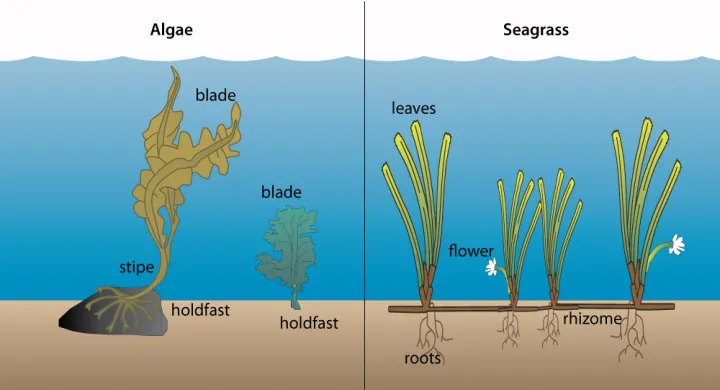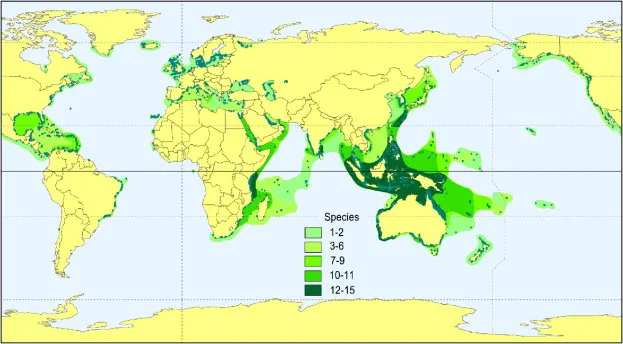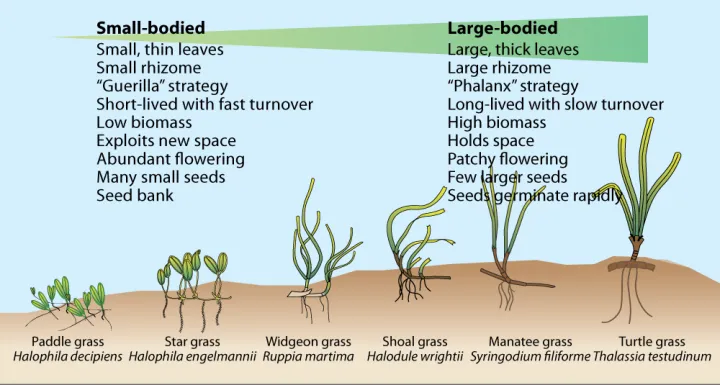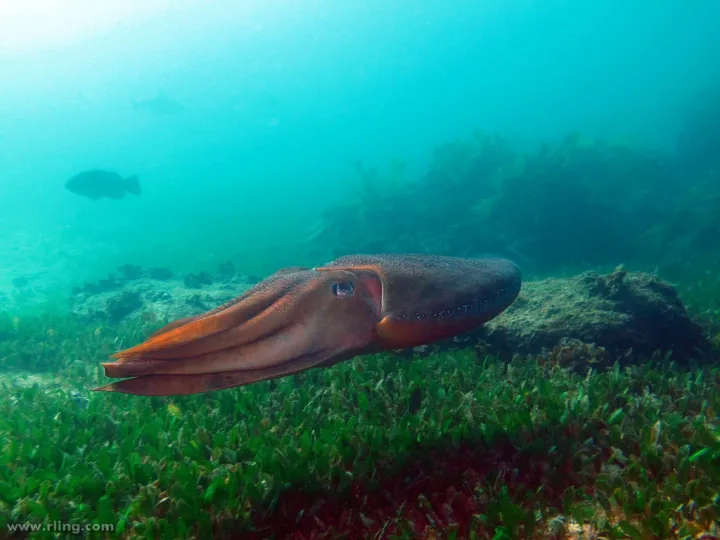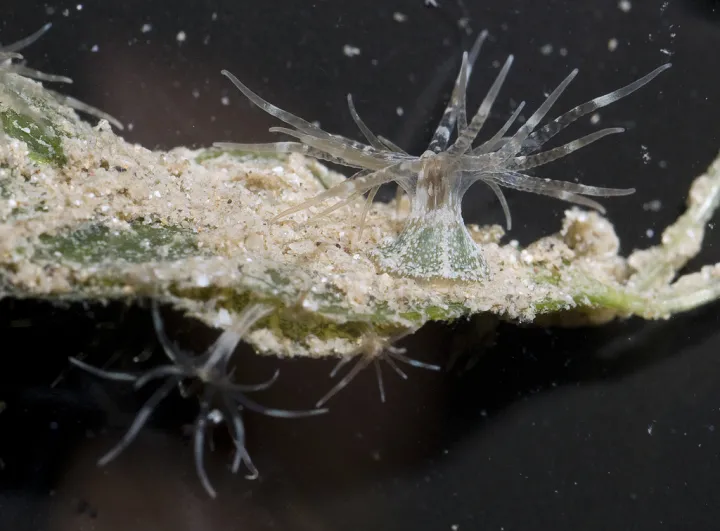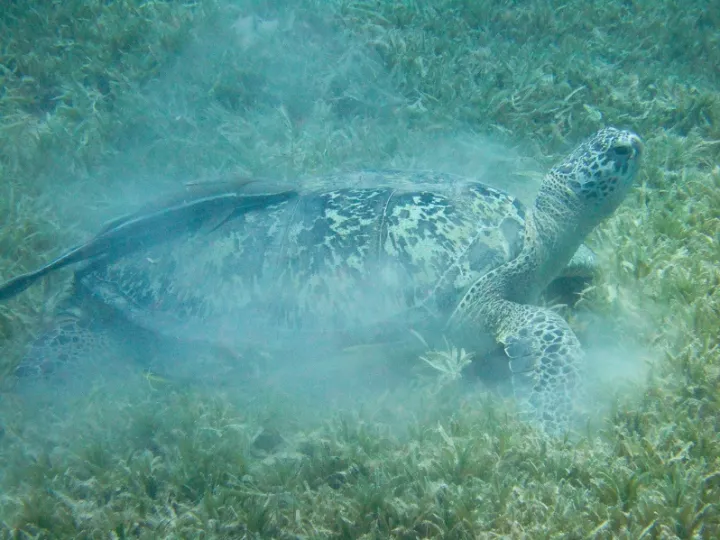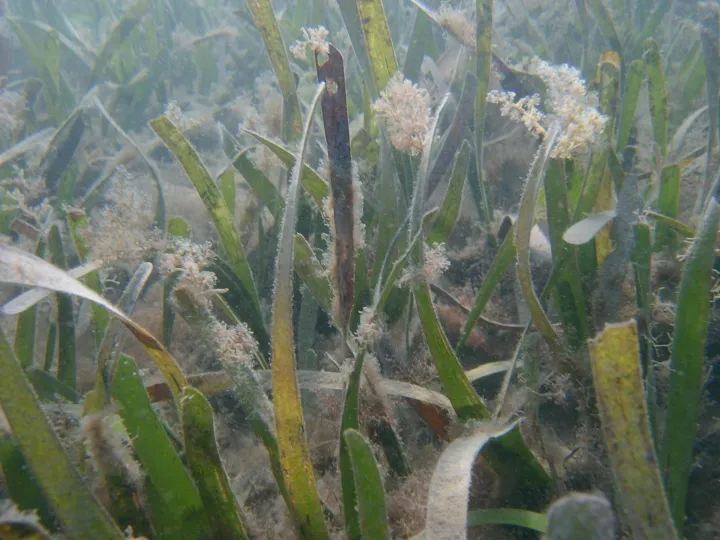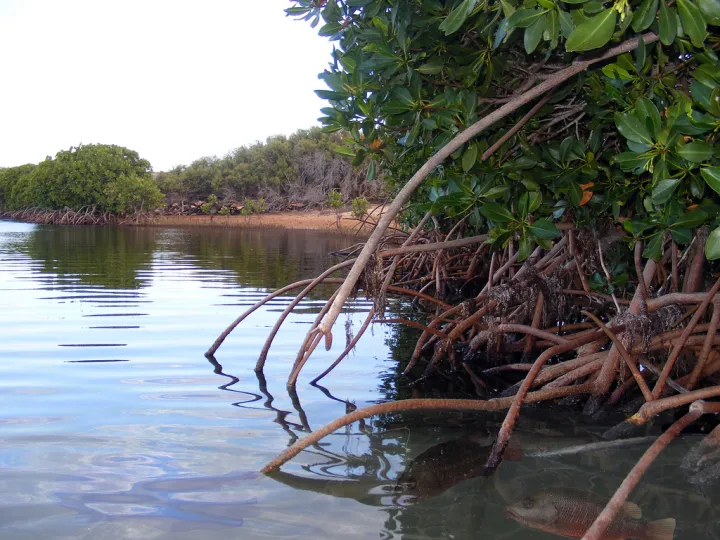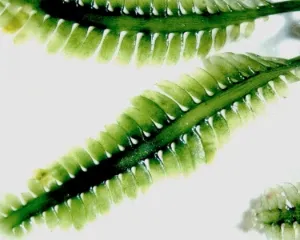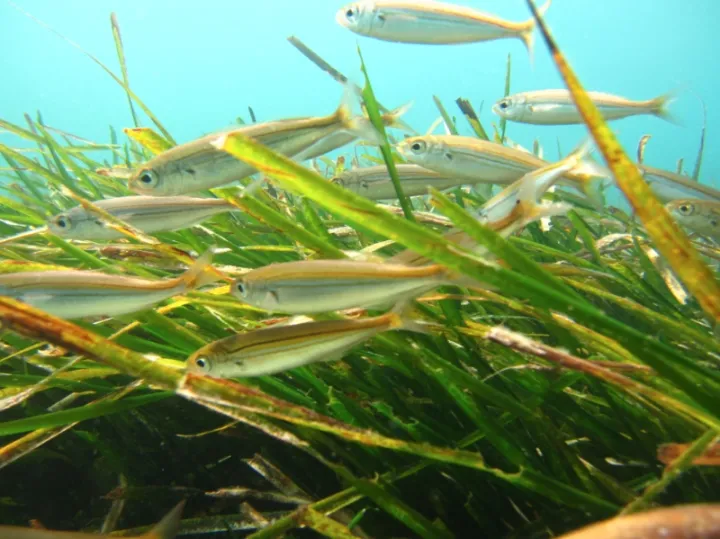
Seagrass and Seagrass Beds
Introduction
Seagrasses are found in shallow salty and brackish waters in many parts of the world, from the tropics to the Arctic Circle. Seagrasses are so-named because most species have long green, grass-like leaves. They are often confused with seaweeds, but are actually more closely related to the flowering plants that you see on land. Seagrasses have roots, stems and leaves, and produce flowers and seeds. They evolved around 100 million years ago, and today there are approximately 72 different seagrass species that belong to four major groups. Seagrasses can form dense underwater meadows, some of which are large enough to be seen from space. Although they often receive little attention, they are one of the most productive ecosystems in the world. Seagrasses provide shelter and food to an incredibly diverse community of animals, from tiny invertebrates to large fish, crabs, turtles, marine mammals and birds. Seagrasses provide many important services to people as well, but many seagrasses meadows have been lost because of human activities. Work is ongoing around the world to restore these important ecosystems.
What Are Seagrasses?
A Plant, Not a Seaweed
Even though seagrasses and seaweeds look superficially similar, they are very different organisms. Seagrasses belong to a group of plants called monocotyledons that include grasses, lilies and palms. Like their relatives, seagrasses have leaves, roots and veins, and produce flowers and seeds. Chloroplasts in their tissues use the sun's energy to convert carbon dioxide and water into sugar and oxygen for growth through the process of photosynthesis. Veins transport nutrients and water throughout the plant, and have little air pockets called lacunae that help keep the leaves buoyant and exchange oxygen and carbon dioxide throughout the plant. Like other flowering plants, their roots can absorb nutrients. Unlike flowering plants on land, however, they lack stomata—the tiny pores on leaves that open and close to control water and gas exchange. Instead, they have a thin cuticle layer, which allows gasses and nutrients to diffuse directly into and out of the leaves from the water. The roots and rhizomes (thicker horizontal stems) of seagrasses extend into the sediment of the seafloor and are used to store and absorb nutrients, as well as anchor the plants. In contrast, seaweeds (algae) are much simpler organisms. They have no flowers or veins, and their holdfasts simply attach to the bottom and are generally not specialized to take in nutrients. Scientists are studying what genes were lost and which were regained as seagrasses evolved from algae in the sea to plants on land, and then transitioned back to the sea. The entire genome of one seagrass, the eelgrass Zostera marina, was sequenced in 2016, helping us understand how these plants adapted to life in the sea, how they may respond to climate warming, and the evolution of salt tolerance in crop plants.
Where are Seagrasses found?
Seagrasses grow in salty and brackish (semi-salty) waters around the world, typically along gently sloping, protected coastlines. Because they depend on light for photosynthesis, they are most commonly found in shallow depths where light levels are high. Many seagrass species live in depths of 3 to 9 feet (1 to 3 meters), but the deepest growing seagrass (Halophila decipiens) has been found at depths of 190 feet (58 meters). While most coastal regions are dominated by one or a few seagrass species, regions in the tropical waters of the Indian and western Pacific oceans have the highest seagrass diversity with as many as 14 species growing together. Antarctica is the only continent without seagrasses.
Growth & Reproduction
Seagrasses grow both vertically and horizontally—their blades reach upwards and their roots down and sideways—to capture sunlight and nutrients from the water and sediment. They spread by two methods: asexual clonal growth and sexual reproduction.
Asexual Clonal Growth: Similar to grasses on land, seagrass shoots are connected underground by a network of large root-like structures called rhizomes. The rhizomes can spread under the sediment and send up new shoots. When this happens, many stems within the same meadow can actually be part of the same plant and will have the same genetic code—which is why it is called clonal growth. In fact, the oldest known plant is a clone of the Mediterranean seagrass Posidonia oceanica, which may be up to 200,000 years old, dating back to the ice ages of the late Pleistocene. In some seagrass species, a meadow can develop from a single plant in less than a year, while in slow-growing species like Posidonia it can take hundreds of years.
Sexual Reproduction: Seagrasses reproduce sexually like terrestrial grasses, but pollination for seagrasses is completed with the help of water. Male seagrass flowers release pollen from structures called stamens into the water. Seagrasses produce the longest pollen grains on the planet (up to 5mm long compared to under 0.1mm for land plants typically), and this pollen often collects into stringy clumps. The clumps are moved by currents until they land on the pistil of a female flower and fertilization takes place. There is also evidence that small invertebrates, such as amphipods (tiny shrimp-like crustaceans) and polychaetes (marine worms), feed on the pollen of one seagrass (Thalassia testudinum), which could help to fertilize the flowers in a way similar to how insects pollinate flowers on land.
Self-pollination happens in some grass species, which can reduce genetic variation. Individual seagrass plants avoid this by producing only male or female flowers, or by producing the male and female flowers at different times. Just like land grasses, fertilized seagrass flowers develop seeds. Seagrass seeds are neutrally buoyant and can float many miles before they settle onto the soft seafloor and germinate to form a new plant. A few seagrass species such as the surfgrass Phylospadix can settle and live on rocky shores. Animals that eat seagrass seeds—including fish and turtles—may incidentally aid with their dispersal and germination if the seeds pass through their digestive tracks and remain viable.
Biodiversity
The 72 species of seagrasses are commonly divided into four main groups: Zosteraceae, Hydrocharitaceae, Posidoniaceae and Cymodoceaceae. Their common names, like eelgrass, turtle grass, tape grass, shoal grass, and spoon grass, reflect their many shapes and sizes and roles in marine ecosystems. Seagrasses range from species with long flat blades that look like ribbons to fern or paddle-shaped leaves, cylindrical or spaghetti blades, or branching shoots. The tallest seagrass species—Zostera caulescens—was found growing to 35 feet (7 meters) in Japan. Some seagrass species are quick growing while others grow much more slowly. These distinct structures and growth forms affect how seagrasses influence their environment and what species live in the habitats they create.
Ecosystem Benefits
Seagrasses are often called foundation plant species or ecosystem engineers because they modify their environments to create unique habitats. These modifications not only make coastal habitats more suitable for the seagrasses themselves, but also have important effects on other animals and provide ecological functions and a variety of services for humans.
Seagrasses have been used by humans for over 10,000 years. They've been used to fertilize fields, insulate houses, weave furniture, thatch roofs, make bandages, and fill mattresses and even car seats. But it's what they do in their native habitat that has the biggest benefits for humans and the ocean. Seagrasses support commercial fisheries and biodiversity, clean the surrounding water and help take carbon dioxide out of the atmosphere. Because of these benefits, seagrasses are believed to be the third most valuable ecosystem in the world (only preceded by estuaries and wetlands). One hectare of seagrass (about two football fields) is estimated to be worth over $19,000 per year, making them one of the most valuable ecosystems on the planet.
Key Services
Modification of the Physical Environment
Seagrasses are known as the "lungs of the sea" because one square meter of seagrass can generate 10 liters of oxygen every day through photosynthesis. Seagrass leaves also absorb nutrients and slow the flow of water, capturing sand, dirt and silt particles. Their roots trap and stabilize the sediment, which not only helps improve water clarity and quality, but also reduces erosion and buffers coastlines against storms. Seagrasses can further improve water quality by absorbing nutrients in runoff from the land. In nutrient poor regions, the seagrass plants themselves help nutrient cycling by taking up nutrients from the soil and releasing them into the water through their leaves, acting as a nutrient pump.
Creation of Living Habitat
Seagrasses are often called nursery habitats because the leafy underwater canopy they create provides shelter for small invertebrates (like crabs and shrimp and other types of crustaceans), small fish and juveniles of larger fish species. Many species of algae and microalgae (such as diatoms), bacteria and invertebrates grow as “epiphytes” directly on living seagrass leaves, much like lichens and Spanish moss grow on trees. Other invertebrates grow nestled between the blades or in the sediments—such as sponges, clams, polychaete worms and sea anemones. The accumulation of smaller organisms amongst and on the seagrass blades, as well as the seagrass itself, attracts bigger animals. As a result, seagrasses can be home to many types of fish, sharks, turtles, marine mammals (dugongs and manatees), mollusks (octopus, squid, cuttlefish, snails, bivalves), sponges, crustaceans (shrimp, crabs, copepods, isopods and amphipods) polychaete worms, sea urchins and sea anemones—and the list goes on.
Some of these organisms are permanent residents in seagrass meadows, while others are temporary visitors. A single acre of seagrass can support upwards of 40,000 fish and 50 million small invertebrates, and there are often tens to hundreds more animals in a seagrass bed compared to adjacent bare sandy areas. Hundreds of species live in the seagrass near the Smithsonian Marine Station at Fort Pierce in Florida. A number of the species that depend on seagrasses are important for commercial and recreational fisheries. In fact, in all regions of the world fishermen will specifically seek out seagrass beds for their abundance of fish. It is because of the wide variety of different species that live amongst the grasses that seagrass beds often form important "biodiversity hotspots." Not only do seagrasses support a diversity of marine life, but populations of a given seagrass species can themselves be very genetically diverse and this diversity itself is linked to higher animal abundances. Understanding how seagrass genotypic diversity does this is an active area of research.
Foundation of Coastal Food Webs
Seagrass beds are important feeding grounds for thousands of species around the world, and they support this diverse food web in three different ways. Some organisms—primarily large grazers like manatees, dugongs, green sea turtles and geese—eat the living leaves directly, and seagrass forms a major component of their diets. For example, an adult dugong eats about 64 to 88 pounds (28 to 40 kg) of seagrass a day, while an adult green sea turtle can eat about 4.5 pounds (2 kg) per day. Many of these large grazers are endangered, in large part because of habitat destruction and hunting, but once they were very common. It's estimated that before Europeans settled the Americas in the 1400's, the number of green sea turtles supported by seagrass meadows was 15 to 20 times the number and biomass of large hooved animals in the Serengeti Desert alive today. These abundant large grazers probably kept seagrass meadows cropped short like a putting green.
The epiphytic organisms growing on the surface of the seagrass blades provide other sources of food. Some epiphytic bacteria can extract nitrogen from the environment and make it available to larger animals. Small invertebrate mesograzers, such as crustaceans and snails, feed on epiphytes, and in doing so can help keep the seagrass clean, acting as mutualistic partners (or housekeepers) that promote seagrass growth. They are in turn consumed by larger crustaceans, fish and birds and are important links in the coastal food web. But, this partnership isn't always positive. Occasionally when some mesograzer species are at very high densities they can create thick masses of mucus and sediment tubes that block light to the seagrass leaves, and they can even eat the seagrass directly.
Dead seagrass leaves also play an important role in coastal ecosystems. When the leaves die, they decay on the sediment or are washed onto the beach, supporting a diverse community of decomposers that thrive on rotting material. Some of these living and dead seagrass blades are also washed to other areas of the ocean, feeding organisms in ecosystems as far as the deep sea.
Small invertebrates, such as these crustaceans (left) and gastropods (right), can help keep seagrasses clean by consuming epiphytic algae. Photos (clockwise from top left) by Chris Nicolini, Matt Whalen, Jonas Thormar and Camilla Gustafsson
Blue Carbon
Seagrasses are capable of capturing and storing a large amount of carbon from the atmosphere. Similar to how trees take carbon from the air to build their trunks, seagrasses take carbon from the water to build their leaves and roots. As parts of the seagrass plants and associated organisms die and decay, they can collect on the seafloor and become buried, trapped in the sediment. It has been estimated that in this way the world's seagrass meadows can capture up to 83 million metric tons of carbon each year. The carbon stored in sediments from coastal ecosystems including seagrass meadows, mangrove forests and salt marshes is known as "blue carbon" because it is stored in the sea. While seagrasses occupy only 0.1 percent of the total ocean floor, they are estimated to be responsible for up to 11 percent of the organic carbon buried in the ocean. One acre of seagrass can sequester 740 pounds of carbon per year (83 g carbon per square meter per year), the same amount emitted by a car traveling around 3,860 miles (6,212 km).
Threats & Conservation
Unfortunately, seagrasses are in trouble. Seagrass coverage is being lost globally at a rate of 1.5 percent per year. That amounts to about 2 football fields of seagrass lost each hour. It's estimated that 29 percent of seagrass meadows have died off in the past century. In a 2011 assessment, nearly one quarter of all seagrass species for which information was adequate to judge were threatened (endangered or vulnerable) or near threatened using the International Union for the Conservation of Nature (IUCN) Red List criteria. This is especially worrying because seagrass losses are projected to have severe impacts on marine biodiversity, the health of other marine ecosystems, and on human livelihoods. Additionally, some threatened marine species such as sea turtles and marine mammals live in seagrass habitats and rely on them for food. For every seagrass species there is on average more than one associated threatened marine species. In fact, the only marine plant listed as endangered in the United States is a seagrass (Halophila johnsonii) found in Florida.
Threats to Seagrasses
Seagrasses are vulnerable to physical disturbances, such as wind-driven waves and storms. Some animals, such as skates and rays, disturb the rhizomes and roots of seagrasses, ripping up the seagrass as they forage for buried clams and other invertebrates. However, the direct and indirect effects of human activities account for most losses of seagrass beds in recent decades. Some fast growing seagrass meadows are able to rebound from disturbances, but many grow slowly over the course of centuries and are likely to be slow to recover and are thus most vulnerable.
Nutrients, such as those from fertilizers and pollution, wash off the land and into the water, causing algal blooms that block sunlight necessary for seagrass growth. Sediment washing into the water from agriculture and land development can also damage seagrass beds by both smothering the seagrass and blocking sunlight. Similarly, dredging can both directly remove seagrass plants and cause lower light levels because of increased amounts of sediments in the water. Boat anchors and propellers can leave "scars" in a seagrass bed—killing sections of the seagrass and fragmenting the habitat. This fragmentation of seagrass beds can increase erosion around the edges, as well as influence animal use and movement within the seagrass bed.
Disease has also devastated seagrasses. In the early 1930s, a large die-off of up to 90 percent of all eelgrass (Zostera marina) growing in temperate North America was attributed to a "wasting disease". This die-off was so severe that a small snail specialized to live on eelgrass went extinct as a result. The disease was caused by the slime mold-like protist, Labyrinthula zosterae, which also ravaged eelgrass populations in Europe. This disease still affects eelgrass populations in the Atlantic and has contributed to some recent losses, though none as catastrophic as in the 1930s. Eelgrass leaves that are weak or stressed are more susceptible to the disease, developing brown spots and lesions that reduce the plant's ability to photosynthesize, eventually killing the plant. Healthy plants are thought to be resistant to the disease, indicating importance of reducing other stressors like pollution. Lower seawater salinity may also increase susceptibility to the Labyrinthula pathogen.
Episodes of warm seawater temperatures can also damage seagrasses. Temperature affects how enzymes and metabolism work, influencing how organisms grow. Rising water temperatures tend to increase rates of seagrass respiration (using up oxygen) faster than rates of photosynthesis (producing oxygen), which makes them more susceptible to grazing by herbivores. Increased temperature also increases seagrass light requirements, influences how quickly seagrasses can take up nutrients in their environment, and can make seagrasses more susceptible to disease. Large eelgrass declines have been observed in the Chesapeake Bay in years in which water temperatures have persisted for several days above 30°C (86°F), the thermal limit for this species.
Removal of fish can also lead to seagrass death by disrupting important components of the food web. When large predators are removed, intermediate predators can become more abundant, and they in turn cause the decline of the smaller organisms that keep the blades of the seagrasses clean. This has been observed most strikingly in the Baltic sea with the disappearance of cod due to overfishing and corresponding increases in smaller fishes and crustaceans which limited epiphyte-grazing invertebrates, resulting in seagrass decline.
In addition to the small epiphytic algae, larger algae also compete with seagrasses, and introduced invasive seaweed species can displace native seagrass species. One important example is the invasion of Caulerpa taxifolia, a seaweed nicknamed "the killer algae." Released into the Mediterranean in the 1980s from aquaria, by 2000 it covered more than 131 square kilometers (50 square miles) of the Mediterranean coastline, overgrowing and replacing the native Neptune seagrass (Posidonia oceanica) and reducing the ecosystem's biodiversity. Since then, invasive Caulerpa has been found in California and southwestern Australia where eradication programs are in place to prevent its spread.
Protecting and Restoring Seagrass Beds
Most management that protects seagrasses focuses on maintaining their biodiversity and the services these habitats provide for humans and ecosystems. There is no international legislation for seagrasses, and so protection typically occurs by local and regional agencies. Actions taken to help seagrasses include limiting damaging practices such as excessive trawling and dredging, runoff pollution and harmful fishing practices (such as dynamite or cyanide fishing).
There are also attempts to rebuild and restore seagrass beds, often by planting seeds or seedlings grown in aquaria, or transplanting adult seagrasses from other healthy meadows. Some of the most successful restoration stories come from the Chesapeake Bay and coastal Virginia in the Eastern United States where, through 2014, the Virginia Institute of Marine Science has seeded 456 acres with 7.65 million seagrass seeds. As of 2015, the seagrass Zostera marina has increased from these seeded plots to cover 6,195 acres. Seagrass restoration in Tampa Bay, Florida, has also experienced important success including improvements in water quality and the associated fish community. For restoration to work, it is critical that the causes of the original decline in seagrasses have been eliminated.
However, seagrass populations globally are still in trouble. Some simple steps everyone can take to help seagrasses and other marine habitats include: don't litter, limit the amount of fertilizer and pesticides you use, don't dump anything hazardous down the drain, be careful when boating by going slow and avoiding shallow areas, and support local conservation efforts.
Seagrass at the Smithsonian
Because of their ecologic importance and global distribution, seagrass are important study systems for understanding how coastal habitats work and respond to environmental changes. A network of scientists are using the seagrass Zostera marina as a model species to test how biodiversity—the number of types of animal species and genetically different plants—may help protect these important plants against threats such as pollution and overfishing. Called the Zostera Experimental Network (ZEN), this program was initiated in 2011 by the Smithsonian Institution's Tennenbaum Marine Observatories Network director Dr. Emmett Duffy. These scientists conduct coordinated, simultaneous surveys and experiments in eelgrass habitats at 50 locations across the Northern Hemisphere to address those questions. The newer Thalassia Experimental Network (TEN), run by scientists working with the Smithsonian Institution's MarineGEO program, uses similar approaches to test those questions in tropical Thalassia testudinum habitats in the Florida Keys, Panama and Belize. Additionally, SeagrassNet monitors 122 seagrass beds across the world to track patterns in seagrass health. By working together, these international science teams hope to not only understand how these critical coastal habitats work, but how to best protect them and ensure their existence in the future.
Additional Resources
Seagrass Habitats at Indian River Lagoon – Smithsonian Marine Station at Fort Pierce
Economic Values of Coral Reefs, Mangroves, and Seagrasses – A Global Compilation 2008 (PDF)
Importance of Seagrass – Florida Fish and Wildlife Conservation Commission
ZEN (Zostera Experimental Network)
Seagrass Educators Handbook (PDF) - Seagrass Watch
News Articles:
Seagrass: unsung ecological hero, potential economic powerhouse (The Science Show)
New report enables creation of carbon credits for restored wetlands (Smithsonian Science News)
Seagrass Restoration Paying Off for Eastern Shore (UVA Today)
Carbon capture and storage: Seagrasses do it for free (ABC)
Books:
Seagrass Ecology by M. Hemming and C.M. Duarte
Seagrasses: Biology, ecology and conservation by A.W.D. Larkum, R.J. Orth and C.M. Duarte
Global Seagrass Research Methods edited by F.T. Short and R.G. Coles
World Atlas of Seagrasses by E.P. Green and F.T. Short
Scientific Papers:
Global seagrass distribution and diversity: A bioregional model - F. Short, T. Carruthers, W. Dennison, and M. Waycott
Biodiversity mediates top–down control in eelgrass ecosystems: a global comparative-experimental approach - J.E. Duffy, P.L. Reynolds, C. Boström, et al.
A Global Crisis for Seagrass Ecosystems - Robert Orth, Tim Carruthers, William Dennison, et al.
The value of the world’s ecosystem services and natural capital (PDF) - Robert Costanza, Ralph D’Arge, Rudolf de Groot, et al.
Extinction risk assessment of the world’s seagrass species - Frederick T. Short, Beth Polidoro, Suzanne R. Livingstone, et al.


